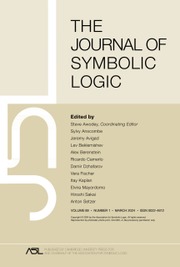No CrossRef data available.
Article contents
On deciding the provability of certain fixed point statements
Published online by Cambridge University Press: 12 March 2014
Extract
Terminology. PA is Peano Arithmetic, classical first-order arithmetic with induction. ⌈A⌉ is the formal numeral in PA for the Gödel number of A. – A is the negation of A, (A&B) is the conjunction of A and B, and Bew(x) is the usual provability predicate for PA. neg(x), conj(x, y), bicond(x, y), and bew(x) are terms of PA such that for all sentences A and B of PA ⊢PA, neg(˹A˺) = ˹−A˺ ⊢PA Conj(˹A˺, ˹B˺)= ˹(A&B)˺ ⊢PA bicond(˹A˺, ˹B˺)= ˹(A ↔ B)˺, and ⊢PA bew(˹A˺) = ˹Bew(˹A˺)˺. T is the sentence ‘0 = 0’ and Con is the usual sentence expressing the consistency of PA. If A (x) is any formula of PA, then a fixed point of A(x) is a sentence S such that ⊢PAS ↔ A(˹S˺). (It is well known that every formula of PA with one free variable has a fixed point.) The P-terms are defined inductively by: the variable x is a P-term; if t(x) and u(x) are P-terms, so are neg(t(x)), conj(t(x), u(x)), and bew(t(x)). A basic P-formula is a formula Bew(t(x)), where t(x) is a P-term; and a P-formula is a truth-functional combination of basic P-formulas. An F-sentence is a member of the smallest class that contains Con and contains −A, (A&B), and −Bew(˹−A˺) whenever it contains A and B. In [B] we gave a decision procedure for the class of true F-sentences.
−Bew(x), Bew(x), and Bew(neg(x)) are examples of P-formulas, and fixed points of these particular P-formulas have been studied by Gödel, Henkin [H] and Löb [L], and Jeroslow [J], respectively. In this note we show how to decide whether or not a fixed point of any given P-formula is provable in PA.
Information
- Type
- Research Article
- Information
- Copyright
- Copyright © Association for Symbolic Logic 1977

